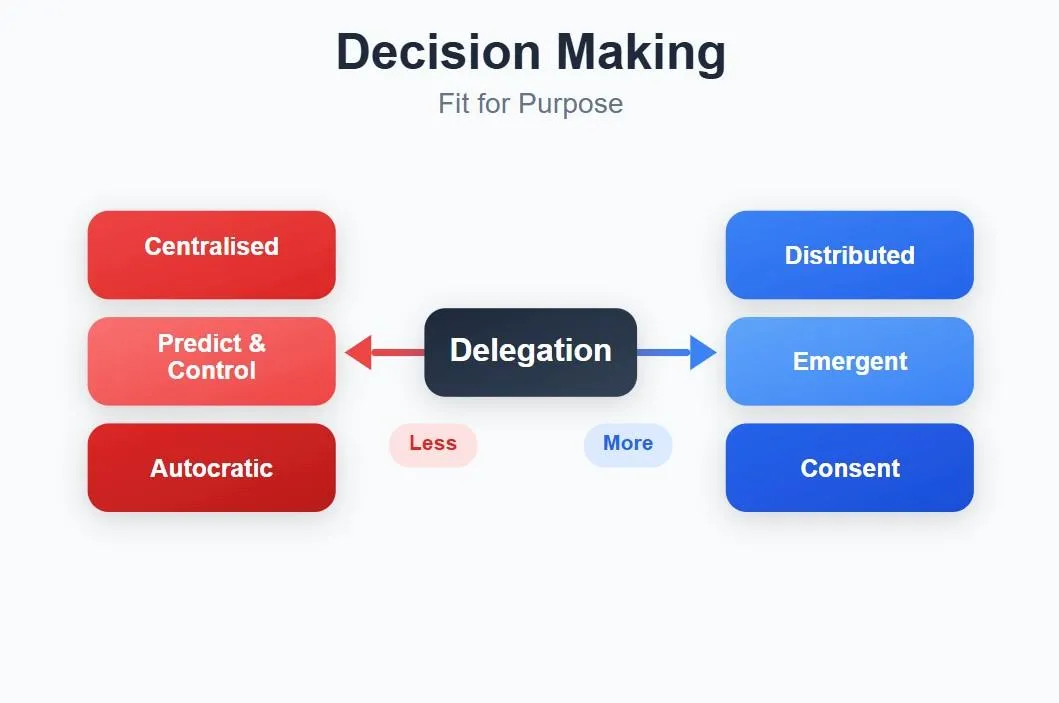
Why Better Decision-Making Fuels Autonomy, Motivation, and Value Creation
I Used to Be Indecisive… Now I’m Not So Sure!
Why Better Decision-Making Fuels Autonomy, Motivation, and Value Creation
One of the key messages from this year’s LAST Conference Adelaide was the power of autonomy and self-management. Over and over again, I found myself reflecting on a simple truth: poor decision-making processes create waste—both in time and human potential.
When you map your value stream from idea to delivery, you’ll find that lead and cycle times are clogged not just by complexity, but by waiting—for approvals, for gates, for dependencies, for someone else to make a call. That “non-value-add” time isn’t just an efficiency problem; it impacts motivation, engagement, and outcomes.
If we want more autonomous teams and faster delivery of value, we need to focus on how decisions get made, and by whom.
I learnt the hard way early on, that just giving permission is not sufficient and may end in tears for your people and teams, situational and adaptive leadership with agreed processes and support are vital to successful change.
Most agile transformations fail because they teach ceremonies, not decision-making.
Why Leaders Still Matter in Self-Managing Teams
A common myth about self-managing teams is that leaders have less to do. In reality, the work doesn’t go away—it just changes.
I’ve seen teams pushed into autonomy without support, guardrails, coaching, or processes. Some people thrive in a blank-slate environment—but most don’t, especially in complex or regulated environments. Leadership doesn’t disappear; it just evolves.
Here are three things leaders can start doing today to foster better decision-making and autonomy:
1. Delegate With Purpose
Look at your current decision-making structure. What decisions can and should be delegated? Start small, build trust, and support people to grow into their new responsibilities.
Even in highly governed environments, we can shift from rigid control (stop signs) to principle-based guidance (roundabouts). The best decisions are often made at the coalface—by the people closest to the work.
2. Influence the System
Leadership isn’t just downward—it goes in every direction. Work with peers, senior leaders, and teams to identify and remove bottlenecks in how decisions flow.
Use data, stories, and empathy to explore what’s happening end-to-end. Guide your teams through the shift—don’t leave them to sink or swim. It’s not easy work, but it’s impactful and rewarding.
3. Share What People Need to Know
You can’t expect great decisions from people who don’t have access to relevant information. Break down silos, share context, and make transparency the default.
You wouldn’t ask someone to cook dinner without telling them what’s in the fridge, who’s coming, or if anyone has allergies. It’s the same at work—information enables autonomy.
What Teams Can Do to Improve Decision-Making
While leadership is essential, decision-making is a team sport. Here are three things teams can start doing right now:
1. Build Clear Processes and Use the Right Tools
Even in agile environments, structure helps. Co-create clear processes for how decisions are made. Who decides what? Who’s consulted? How do we share outcomes?
I’m a big fan of experimenting with:
The Advice Process
Concordance Decision Making
Simple “I propose...” formats
In distributed teams, choose tools that support asynchronous decision-making—a Slack channel can be enough. What matters more is team agreement and clarity.
2. Be Coachable
If you're unsure or need support—ask. Being coachable means staying open, curious, and willing to grow. Don’t fall into the trap of “we tried that before” or “that’ll never work here.” Embrace experimentation.
Sometimes the need for support won’t be obvious to you—but it might be to your peers or leaders. Invite the conversation.
3. Celebrate and Reflect
After trying something new—celebrate!
Look at what worked, what didn’t, and what to try next. Reflection creates learning, builds momentum, and keeps the team engaged.
Make your learning visible. Share your wins (and failures) widely to inspire others and normalize experimentation.
Wrapping Up: Better Decisions, Better Teams
Improving decision-making is about more than speed—it’s about trust, clarity, and growth. It’s the foundation of autonomy and the engine of motivation.
Leadership in self-managing organizations means building the conditions for good decisions:
Delegate authority to where the knowledge is
Influence the broader system
Share the information that makes smart choices possible
Lisa Gill and Karin Tenelius of Tuff Leadership Training describe the foundations of effective self-managing teams as:
🔹 A coaching leadership mindset
🔹 A strong working climate
🔹 A culture of mandate and involvement
These aren’t soft skills—they’re strategic enablers.
Autonomy isn't the absence of leadership. It's leadership that enables others to lead.
So whether you’re a leader or team member, ask yourself:
✅ What decisions am I holding onto that I can let go of?
✅ What support do we need to improve how we decide?
✅ What’s one small experiment we can try this month?
I’d love to hear your stories—what has helped your team build autonomy through better decision-making?


